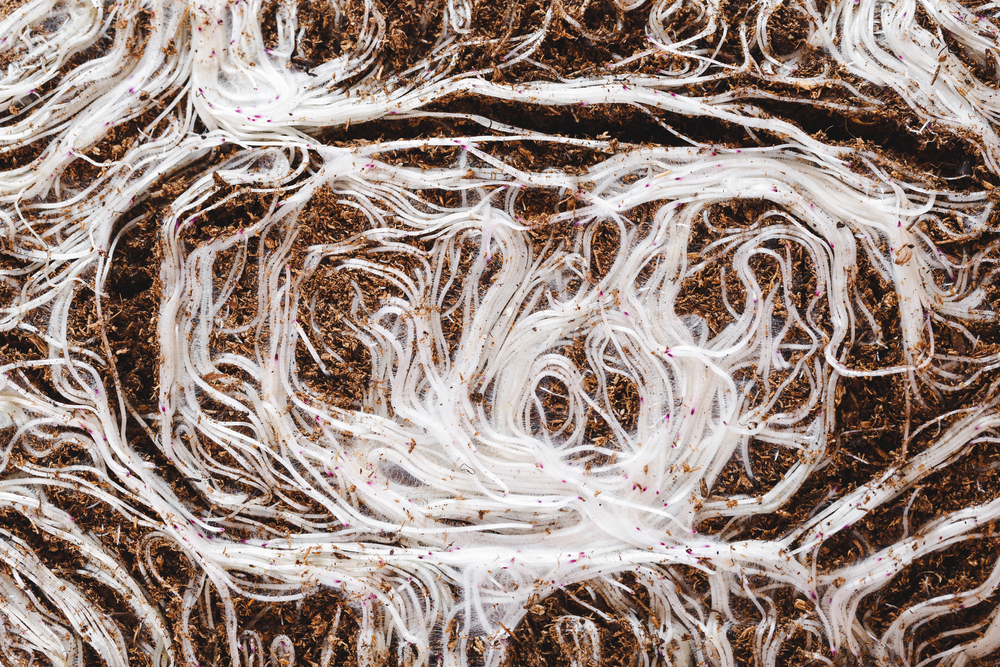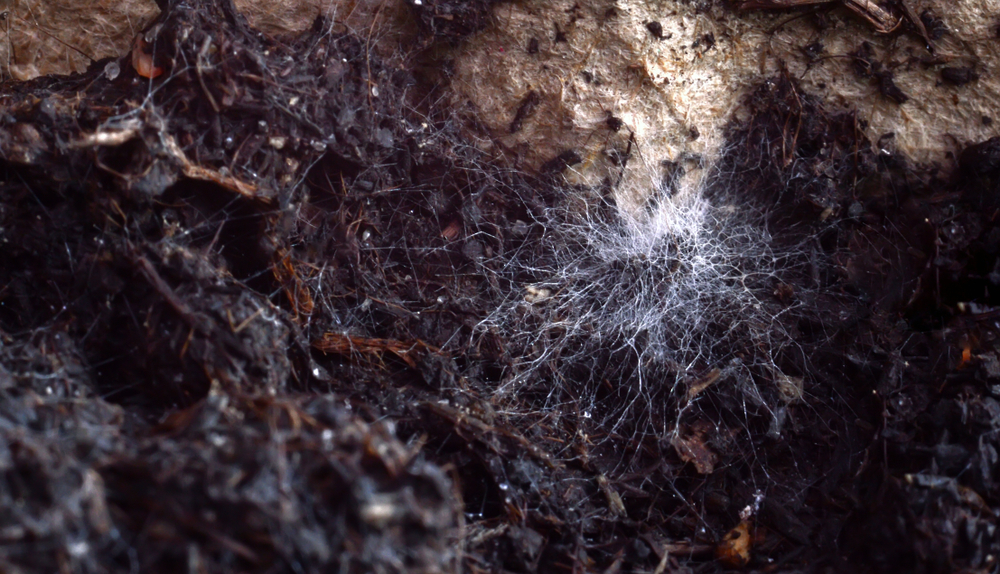Opinion: Does Adding Fungi to Soil Do More Harm Than Good?
The use of mycorrhizal fungi—fungi that grow on plant roots—as biofertilizers is becoming more common. But it could have harmful effects on native ecosystems.
Opinion: Does Adding Fungi to Soil Do More Harm Than Good?
The use of mycorrhizal fungi—fungi that grow on plant roots—as biofertilizers is becoming more common. But it could have harmful effects on native ecosystems.

Fungi that live on plant roots can help with the uptake of nutrients.by ER_09, Shutterstock.
This article is republished from The Conversation under a Creative Commons license. Read the original article.
Invasive, alien species are bad for ecosystems. They reduce biodiversity and disrupt food chains, including our own.
History is full of examples of intentional and unintentional introductions of invasive species. The introduction of cane toads to Northern Australia in the 1930s to fight cane beetles led to decline of many native predators. The fungus that causes chestnut blight snuck into North America via infected nursery stock; four billion trees died in 40 years.
It’s easy enough to see the devastation by invasive species of plants, just look your window: spotted knapweed, Eurasian milfoil and giant hogweed have completely changed communities across North America.
Soil ecosystems
What about creatures in the soil? Have they been affected by invasive species? Which species have gone extinct? Which ones are proliferating? It is important to think about soil as an invisible ecosystem, because many agricultural practices include the deliberate addition of microbes to the soil, biofertilizers.
Biofertilizers are microbes that are grown specifically for application to soil. There are many microbes that are used as biofertilizers, including bacteria and fungi, and the most common application is to improve crop nutrient status. These products are considered by some to be a more sustainable alternative to synthetic fertilizers.
The use of mycorrhizal fungi—fungi that grow on plant roots—as biofertilizers is becoming more common. Applying them as a kind of fertilizer makes sense because these fungi grow in plant roots and help plants get more nutrients from the soil.
Companies encourage farmers to use biofertilizers with the promise that biofertilizers will lead to healthier soil. The number of companies making mycorrhizal fungi has increased dramatically in the last decade—but there’s no easy way to know what they’re selling, where it’s being used and how much is being released into the environment.

My lab looks at how mycorrhizal biofertilizers move in the environment and how they affect native ecosystems. Because mycorrhizas are an important part of all ecosystems, introducing an alien mycorrhizal fungus may have unintended consequences for native mycorrhizas and ecosystems in general.
Alien species
The application of biofertilizers and mycorrhizal products involves introducing potentially invasive species. These products, which are alien to the environments they are placed in, must establish in a novel environment under a wide range of conditions. To do this, they need to compete against, and replace, native fungi. This is the definition of an invasive species.
The use of biofertilizers may not be a big problem if these products stay where we put them, like in the greenhouse or in a farmer’s field. But if there is one thing we’ve learned about microbes in the last 24 months, it is that they move, and they move fast. There is evidence that mycorrhizal fungi can move over long distances, through atmospheric currents or even as passengers on migratory birds.
In all ecosystems, mycorrhizal fungi link plants in a community through hyphae—thin strands of fungus that carry nutrients to plants. In this way, mycorrhizal fungi and their plant hosts become a superorganism—with plants belonging to different species linked via mycorrhizal hyphae (the filaments that make up the network of a fungi).

This allows plants to sense conditions elsewhere in the network by receiving warning chemicals through hyphae if there is a herbivore somewhere in the network and increasing defense chemicals before an attack occurs. Mycorrhizal fungi can also change the flow of sugars from the canopy when a seedling is shaded and needs more carbon.
The problem is, even though these networks are crucial for ecosystems, science does not understand how they are affected by biofertilizers. There is currently no research on how mycorrhizal networks are affected by the introduction of biofertilizers or what it means for ecosystems. Neither is there research beyond my lab of how far these products are moving. But science is clear on one thing: once we release these organisms into the environment, we lose the ability to control them.
Regulating biofertilizers
This is the crux of the matter: we do not know how big of a threat biofertilizers pose to ecosystems. Yet, these products continue to be marketed and released globally, with little or no regulation. In Canada, they are considered soil additives under the Fertilizer Act, which is the federal legislation overseeing the safety of fertilizer and soil supplements. Regulation focuses on the toxicity of biofertilizers to humans and other animals, not their risk as invasive species.
A better framework might be the Plant Protection Act, which exists to protect plants, agriculture and forestry from the spread of plant pests. While mycorrhizal fungi are not pests, they are not universally beneficially in all contexts. For example, these fungi can act as a carbon drain for plants, suppressing their growth under certain conditions. It is not a stretch to say that, in some cases, they might act as plant pests.
If biofertilizers are not universally beneficial for all plants in all conditions, they pose a real threat to soil biodiversity and perhaps even plant diversity. If biofertilizers outcompete local fungi, this could change the composition and productivity of plant communities. This is a problem for natural systems, but also for agriculture and forestry.
We need to better regulate these products to ensure that they are not a threat to ecosystems. The thin skin of soil on our planet is home to the creatures who keep our ecosystems functioning—we must not forget about them in our quest to make agriculture more sustainable.
Miranda Hart is a microbial ecologist at the University of British Columbia Okanagan.
Follow us
This work is licensed under a Creative Commons Attribution-NoDerivatives 4.0 International License.
Want to republish a Modern Farmer story?
We are happy for Modern Farmer stories to be shared, and encourage you to republish our articles for your audience. When doing so, we ask that you follow these guidelines:
Please credit us and our writers
For the author byline, please use “Author Name, Modern Farmer.” At the top of our stories, if on the web, please include this text and link: “This story was originally published by Modern Farmer.”
Please make sure to include a link back to either our home page or the article URL.
At the bottom of the story, please include the following text:
“Modern Farmer is a nonprofit initiative dedicated to raising awareness and catalyzing action at the intersection of food, agriculture, and society. Read more at <link>Modern Farmer</link>.”
Use our widget
We’d like to be able to track our stories, so we ask that if you republish our content, you do so using our widget (located on the left hand side of the article). The HTML code has a built-in tracker that tells us the data and domain where the story was published, as well as view counts.
Check the image requirements
It’s your responsibility to confirm you're licensed to republish images in our articles. Some images, such as those from commercial providers, don't allow their images to be republished without permission or payment. Copyright terms are generally listed in the image caption and attribution. You are welcome to omit our images or substitute with your own. Charts and interactive graphics follow the same rules.
Don’t change too much. Or, ask us first.
Articles must be republished in their entirety. It’s okay to change references to time (“today” to “yesterday”) or location (“Iowa City, IA” to “here”). But please keep everything else the same.
If you feel strongly that a more material edit needs to be made, get in touch with us at [email protected]. We’re happy to discuss it with the original author, but we must have prior approval for changes before publication.
Special cases
Extracts. You may run the first few lines or paragraphs of the article and then say: “Read the full article at Modern Farmer” with a link back to the original article.
Quotes. You may quote authors provided you include a link back to the article URL.
Translations. These require writer approval. To inquire about translation of a Modern Farmer article, contact us at [email protected]
Signed consent / copyright release forms. These are not required, provided you are following these guidelines.
Print. Articles can be republished in print under these same rules, with the exception that you do not need to include the links.
Tag us
When sharing the story on social media, please tag us using the following: - Twitter (@ModFarm) - Facebook (@ModernFarmerMedia) - Instagram (@modfarm)
Use our content respectfully
Modern Farmer is a nonprofit and as such we share our content for free and in good faith in order to reach new audiences. Respectfully,
No selling ads against our stories. It’s okay to put our stories on pages with ads.
Don’t republish our material wholesale, or automatically; you need to select stories to be republished individually.
You have no rights to sell, license, syndicate, or otherwise represent yourself as the authorized owner of our material to any third parties. This means that you cannot actively publish or submit our work for syndication to third party platforms or apps like Apple News or Google News. We understand that publishers cannot fully control when certain third parties automatically summarize or crawl content from publishers’ own sites.
Keep in touch
We want to hear from you if you love Modern Farmer content, have a collaboration idea, or anything else to share. As a nonprofit outlet, we work in service of our community and are always open to comments, feedback, and ideas. Contact us at [email protected].by Miranda Hart, Modern Farmer
March 29, 2022
Modern Farmer Weekly
Solutions Hub
Innovations, ideas and inspiration. Actionable solutions for a resilient food system.
ExploreExplore other topics
Share With Us
We want to hear from Modern Farmer readers who have thoughtful commentary, actionable solutions, or helpful ideas to share.
SubmitNecessary cookies are absolutely essential for the website to function properly. This category only includes cookies that ensures basic functionalities and security features of the website. These cookies do not store any personal information.
Any cookies that may not be particularly necessary for the website to function and are used specifically to collect user personal data via analytics, ads, other embedded contents are termed as non-necessary cookies.
Why don’t you prove they’re harmful before calling for regulation? Certainly more studies should be done, but until they show actual harm rather than unfounded fears, I would be loathe to support any legislation concerning them, as most regulation tends to favor large corporations who can afford the onus of associated testing and fees while edging out the small-scale providers who cannot, and who are also more likely to provide cultures of locally-sourced microbes, in contrast to large suppliers who are more likely to offer a one-size-fits-all product. Your article admits that the spores of these fungi, both native and… Read more »
Thank you for this article. No matter how innocuous or beneficial an introduced species (or chemical, material, byproduct, etc.) may seem, there are always unintended consequences; but thoughtful and thorough research in advance of introduction, as well as monitoring and industry regulation after introduction, should be the founding principles for avoiding and reducing harm.